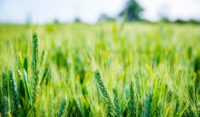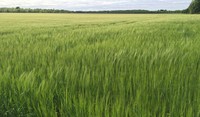
Rising temperature sparks warning to scout for seed weevil

Crops which have struggled through the winter and are yet to come fully into flower will be at the highest risk, with the arrival of seed weevils posing a significant threat to yields – not only as a result of the direct damage caused by eggs being laid in developing seed pods, but also by subsequent populations of brassica pod midges which use the holes left by the hatched weevil larvae to access rapeseed pods and lay their own eggs.
FACT FILE: CABBAGE SEED WEEVIL
Ceuthorrhynchus assimilis (syn= obstrictus)
- Adult: 2.5-3.0mm, grey black, oval shape
- Larva: 5.0-6.0mm, brown head, white body
- Wintering adults emerge when temperate rises above 15oC
- Adults feed on floral buds and developing seedpods
- At around 15-20 days after they emerge, the females start laying eggs inside the seedpods
- The emerging larvae cause further damage
- Cabbage seed midges (Dasineura brassicae) will infest the seedpods, using the holes created by the adult cabbage seed weevil to gain access.


Growers in known seed weevil hotspots such as Yorkshire and Lincolnshire should be particularly vigilant and are advised to use integrated pest management protocols to safeguard the natural predatory effect of beneficial organisms.
The best levels of control will be achieved when treatments are promptly timed and applied in such a way that ensures good spray coverage. Early applications (once thresholds have been reached – see below) will also enable beneficial insects to migrate into the crop where they can limit the extent of any subsequent reinfestations.
SAFEGUARDING BENEFICIAL ORGANISMS
If/when these infestation rates have been exceeded and a pyrethroid-based insecticide is deemed to be the most appropriate mode of action, apply MAVRIK (240 g/litre tau-fluvalinate)at 0.2l/ha in a water volume of 200l/ha.
MAVRIK not only provides fast-acting contact control but has also been proven to have a lower residual impact on beneficial insects compared to other pyrethroids (see ‘Protecting parasitoids’ below).
This reduced toxicity enables populations of natural predators to recover more quickly after crops have been sprayed, therefore ensuring there’s a critical mass ready and able to overcome any subsequent infestations.
Trials have also shown that MAVRIK performs better against seed weevil larva than lambda cyhalothrin CS (see chart below). Nevertheless, although good levels of control are possible, the fact that each individual weevil typically lays up to 30 eggs means that a few larvae are still likely to survive in a treated crop. Maintaining a strong population of beneficial insects to sweep up any surviving larvae is therefore essential to good crop performance.
PROTECTING PARASITOIDS
Work carried out in 2019 and 2020 by Johannes Hausmann and Meike Brandes at the Julius Kühn-Institute (JKI) in Germany has shown that the application of MAVRIK at the full flowering stage of oilseed rape (BBCH 65–67) doesn’t inhibit the beneficial effects of insects that feed on Cabbage seed weevil.
The trial studied the effects of insecticides on three Cabbage seed weevil parasites – Mesopolobus morys (Calchid wasps), Stenomalina gracilis and Trichomalus perfectus – and concluded that any MAVRIK residues still present on plant tissue when the parasitoids were active did not inhibit their prey-seeking activity. As such, all three species were able to target surviving weevil larvae which had not been controlled by the earlier insecticide application.

Applying MAVRIK early in the lifecycle of pest infestations reduces the potential impact on beneficial insects arriving after the insecticide has been applied.
CABBAGE SEED WEEVIL THRESHOLDS FOR INSECTICIDE APPLICATION
Northern UK: one seed weevil in every two plants (BBCH 63-70)
Elsewhere: one per plant (BBCH 63-70)

MAVRIK (240 g/litre tau-fluvalinate) is a highly active and novel pyrethroid which has less impact on beneficial organisms such as honeybees compared to other pyrethroid insecticides. It provides effective, fast-acting contact control of aphids, pollen beetle and cabbage seed weevil.


